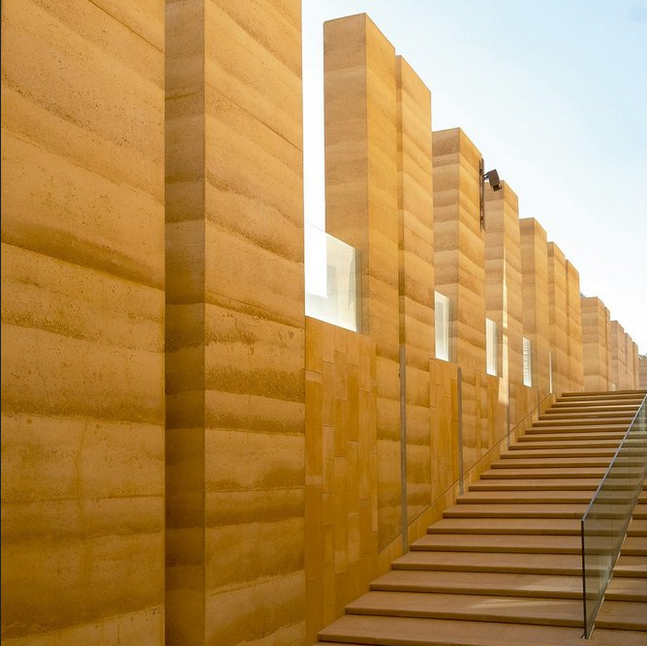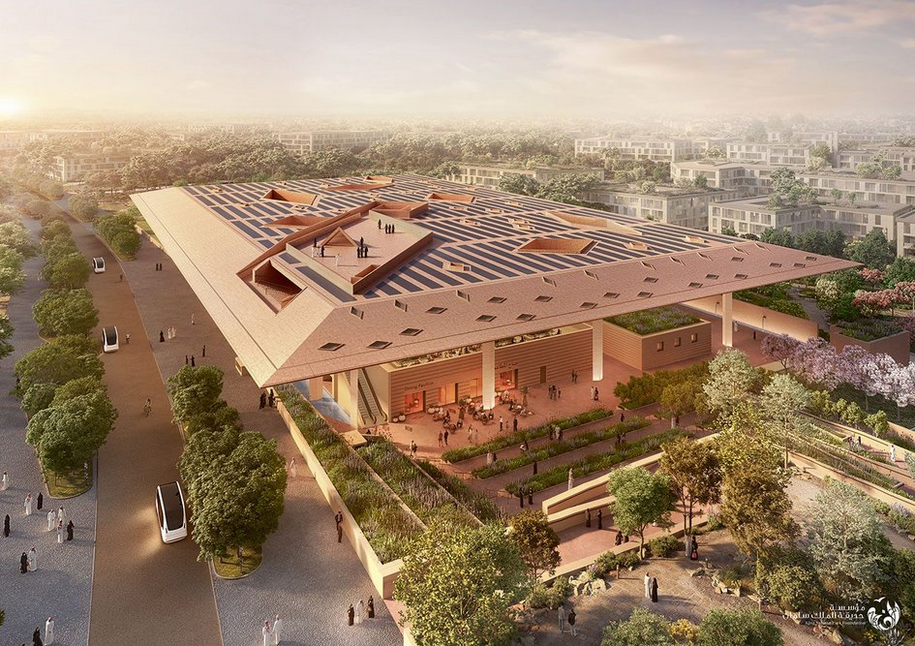When Riyadh-based Syn Architects organized workshops on rammed earth construction recently, it was amazed by the level of interest. Hanno Burtscher of Earthman led the workshops; Syn had worked with him on its recent Desert X rammed earth installation in AlUla. He also oversaw the rammed earth construction on a visitor pavilion in Riyadh.
 2000m² of rammed earth walls are featured in King Abdulaziz Center for World Culture and the technique is also a key element of the Diriyah Art Futures museum, recently completed by Italian architect Amedeo Schiattarella. “When we started working in Saudi Arabia 16 years ago, we found a country which was strongly influenced by Western architecture. We wanted to work in a different way, with respect for the diversity of Saudi architecture,” he says.
2000m² of rammed earth walls are featured in King Abdulaziz Center for World Culture and the technique is also a key element of the Diriyah Art Futures museum, recently completed by Italian architect Amedeo Schiattarella. “When we started working in Saudi Arabia 16 years ago, we found a country which was strongly influenced by Western architecture. We wanted to work in a different way, with respect for the diversity of Saudi architecture,” he says.
 The recent use of rammed earth shows a resurgence of interest in the kingdom’s earthen architectural heritage of adobe – a building tradition using air-dried mud brick that was widespread until the late 20th century. At AlUla, Egyptian architect Shahira Fahmy has completed The House Hotel as part of the practice’s restoration and rehabilitation of the adobe old town.
The recent use of rammed earth shows a resurgence of interest in the kingdom’s earthen architectural heritage of adobe – a building tradition using air-dried mud brick that was widespread until the late 20th century. At AlUla, Egyptian architect Shahira Fahmy has completed The House Hotel as part of the practice’s restoration and rehabilitation of the adobe old town.
 Rammed earth is not traditional to Saudi Arabia. Characterized by distinctive strata-like horizontal lines, it is formed by earth layers compressed in temporary formwork, with wall thickness varying depending on whether it is loadbearing, and whether the mix includes stabilizers.
Rammed earth is not traditional to Saudi Arabia. Characterized by distinctive strata-like horizontal lines, it is formed by earth layers compressed in temporary formwork, with wall thickness varying depending on whether it is loadbearing, and whether the mix includes stabilizers.
 According to Professor Dr Khalid Alskait rammed earth offers many advantages as a local material with a low carbon footprint and good thermal mass. It can also, he says, be combined with earth tube cooling techniques in desert areas. “In moderate desert climates, it’s certainly a good building material because it regulates humidity inside the building, keeps the building relatively cool in warmer days and warm in colder days, and will live long… But you need practical knowledge of how to do it. The moisture content, the soil mix and the ramming method are critical elements for successful building,” he says.
According to Professor Dr Khalid Alskait rammed earth offers many advantages as a local material with a low carbon footprint and good thermal mass. It can also, he says, be combined with earth tube cooling techniques in desert areas. “In moderate desert climates, it’s certainly a good building material because it regulates humidity inside the building, keeps the building relatively cool in warmer days and warm in colder days, and will live long… But you need practical knowledge of how to do it. The moisture content, the soil mix and the ramming method are critical elements for successful building,” he says.
 For Syn, rammed earth resonates with the adobe vernacular tradition while being more durable and offering the low-carbon benefits of local sourcing. Earthman’s Burtscher says rammed earth appeals to architects because it is sustainable, locally sourced and has the potential to help realize their visions. “You can easily shape clean structures, clean lines, and it’s my understanding that international architects are looking into rammed earth as a great material for their designs because it comes from the area and so is super-sustainable. Most people love the layers but that’s subjective. One fact that isn’t subjective is the thermal performance,” he says, adding that this creates saving on energy use and the cost of air-conditioning, and increasing the quality of the interior environment.
For Syn, rammed earth resonates with the adobe vernacular tradition while being more durable and offering the low-carbon benefits of local sourcing. Earthman’s Burtscher says rammed earth appeals to architects because it is sustainable, locally sourced and has the potential to help realize their visions. “You can easily shape clean structures, clean lines, and it’s my understanding that international architects are looking into rammed earth as a great material for their designs because it comes from the area and so is super-sustainable. Most people love the layers but that’s subjective. One fact that isn’t subjective is the thermal performance,” he says, adding that this creates saving on energy use and the cost of air-conditioning, and increasing the quality of the interior environment.
You can read the original article at www.ribaj.com


Just how feasible is the NEOM project? The NEOM project aims to build a 170 kilometers long linear city, a 400x400x400 metre cube, etc.
This is obviously an ambitious project.
The Lord is my shepherd and I shall not want. Psalm 23:1
How much will it cost to build a 2-story single family dwelling?
Thank Jesus for your cooperation in this matter, obey Jesus.
As for materials costs, these vary from place to place and choices that you might make, so it is hard to estimate. In general most plans can be built for no more than the average cost per square foot that is common in your area, something that you can find out from a local realtor, contractor, or banker perhaps. If you do much of the work yourself, this can make a big difference, and how good you are at finding deals on materials is a factor. So it all depends…
That depends. Are you able and does the municipal government allow you to do much of the construction work yourself, or will contractors be required? How large will the dwelling be? How many bathrooms if any? What style do you want your new house to be? In what state and county are you planning on building? Etc. The average cost to build a standard house in the United States is around $230 to $400 per square foot, but with alternate construction materials such as earth-bag, straw-bale, cordwood, etc, and a great deal of DIY elbow grease, construction costs can be halved or quartered. In most of the areas that permit such alternative materials and methods, you could probably build a complete earthbag beehive style dome, roundhouse or simple rectangular dwelling for between $68 and $100 per square foot. This range of cost estimates includes the building shell, basic electricity and plumbing, and basic finishes. It also assumes the house is to have only one bathroom and a kitchenette. I suspect the other alternative materials will result in similar price per square foot ranges.